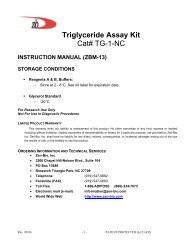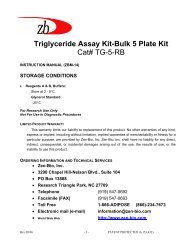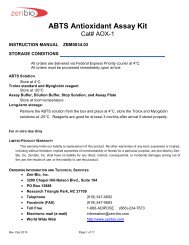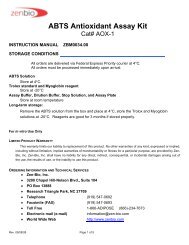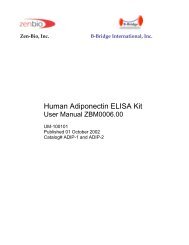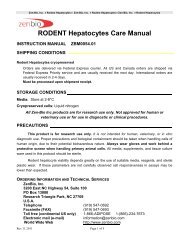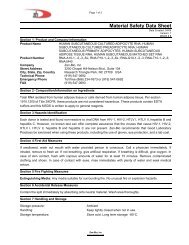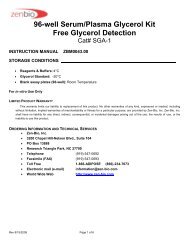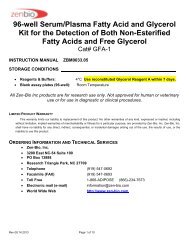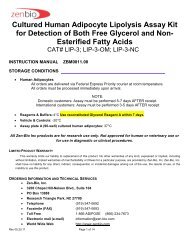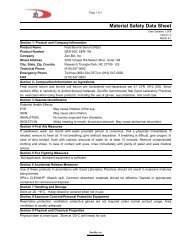ORAC Antioxidant Assay Kit (AOX-2) (pdf) - Zen-Bio Inc.
ORAC Antioxidant Assay Kit (AOX-2) (pdf) - Zen-Bio Inc.
ORAC Antioxidant Assay Kit (AOX-2) (pdf) - Zen-Bio Inc.
Create successful ePaper yourself
Turn your PDF publications into a flip-book with our unique Google optimized e-Paper software.
<strong>ORAC</strong> <strong>Antioxidant</strong> <strong>Assay</strong> <strong>Kit</strong><br />
(60 point kit)<br />
Cat# <strong>AOX</strong>-2<br />
INSTRUCTION MANUAL<br />
ZBM0035.02<br />
STORAGE CONDITIONS<br />
All orders are delivered via Federal Express Priority courier at 4°C.<br />
All orders must be processed immediately upon arrival. Any adverse conditions upon<br />
arrival must be reported within 7 days.<br />
Fluorescein Solution<br />
Remove from box and store at 4°C<br />
Trolox Standard and AAPH Reagent<br />
Remove from box and store at -20°C<br />
<strong>AOX</strong> <strong>Assay</strong> Buffer and black assay plate<br />
Store at Room Temperature<br />
Long-term Storage<br />
Reagents are good for at least 3 months upon arrival if stored properly.<br />
New Bottom Read<br />
<strong>Assay</strong>!<br />
For in vitro Use Only<br />
LIMITED PRODUCT WARRANTY<br />
This warranty limits our liability to replacement of this product. No other warranties of any kind, expressed or implied,<br />
including without limitation, implied warranties of merchantability or fitness for a particular purpose, are provided by <strong>Zen</strong>-<br />
<strong>Bio</strong>, <strong>Inc</strong>. <strong>Zen</strong>-<strong>Bio</strong>, <strong>Inc</strong>. shall have no liability for any direct, indirect, consequential, or incidental damages arising out of<br />
the use, the results of use, or the inability to use this product.<br />
ORDERING INFORMATION AND TECHNICAL SERVICES<br />
<strong>Zen</strong>-<strong>Bio</strong>, <strong>Inc</strong>.<br />
3200 NC East Highway 54, Suite 100<br />
PO Box 13888<br />
Research Triangle Park, NC 27709<br />
Telephone (919) 547-0692<br />
Facsimile (FAX) (919) 547-0693<br />
Toll Free 1-866-ADIPOSE (866)-234-7673<br />
Electronic mail (e-mail)<br />
World Wide Web<br />
information@zen-bio.com<br />
http://www.zenbio.com<br />
Rev. July 2011 Page 1 of 9
TABLE OF CONTENTS<br />
PAGE#<br />
Introduction 3<br />
Principle of <strong>Assay</strong> 4<br />
Items <strong>Inc</strong>luded in the <strong>Kit</strong> 4<br />
Sample Preparation 5<br />
<strong>Assay</strong> Procedure 6<br />
Trolox Standard Curve 7<br />
Appendix A: Plate layout 8<br />
Appendix B: Protocol Flowchart 9<br />
References 9<br />
Rev. July 2011 Page 2 of 9
Net AUC<br />
INTRODUCTION<br />
Free radicals and reactive oxygen species (ROS) are highly reactive molecules that are<br />
generated by normal cellular processes, environmental stresses, and UV irradiation. ROS react with<br />
cellular components, damaging DNA, carbohydrates, proteins, and lipids causing cellular and tissue<br />
injury. Excess production of reactive oxygen species can also lead to inflammation, premature aging<br />
disorders, and several disease states, including cancer, diabetes, and atherosclerosis. Organisms have<br />
developed complex antioxidant systems to protect themselves from oxidative stress, however, excess<br />
ROS can overwhelm the systems and cause severe damage.<br />
The <strong>Zen</strong>-<strong>Bio</strong> <strong>ORAC</strong> (Oxygen Radical Absorbance Capacity) <strong>Antioxidant</strong> <strong>Assay</strong> <strong>Kit</strong> can be used to<br />
determine the total antioxidant capacity of biological fluids, cells, and tissue. It can also be used to<br />
assay the antioxidant activity of naturally occurring or synthetic compounds for use as dietary<br />
supplements, topical protection, and therapeutics. The assay measures the loss of fluorescein<br />
fluorescence over time due to peroxyl-radical formation by the breakdown of AAPH (2,2’-azobis-2-<br />
methyl-propanimidamide, dihydrochloride). Trolox [6-Hydroxy-2,5,7,8-tetramethylchroman-2-carboxylic<br />
acid], a water soluble vitamin E analog, serves as a positive control inhibiting fluorescein decay in a<br />
dose dependent manner. The <strong>ORAC</strong> assay is a kinetic assay measuring fluroescein decay and<br />
antioxidant protection over time. The antioxidant activity in biological fluids, cells, tissues, and natural<br />
extracts can be normalized to equivalent Trolox units to quantify the composite antioxidant activity<br />
present. This assay measures antioxidant activity by hydrogen atom transfer and when combined with<br />
<strong>Zen</strong>-<strong>Bio</strong>’s ABTS antioxidant assay kit, provides a comprehensive analysis of a test sample’s antioxidant<br />
activity.<br />
Net AUC<br />
40<br />
30<br />
Trolox<br />
EGCG<br />
Gallic Acid<br />
20<br />
10<br />
0<br />
0 25 50 75 100<br />
Sample (uM)<br />
Figure 1. Effects of antioxidants in <strong>ORAC</strong> assay<br />
Trolox, Epigallocatechin gallate (EGCG), and Gallic acid were tested for their antioxidant<br />
activity in the <strong>ORAC</strong> antioxidant assay.<br />
Rev. July 2011 Page 3 of 9
PRINCIPLE OF THE ASSAY<br />
A peroxyl radical (ROO . ) is formed from the breakdown of AAPH (2,2’-azobis-2-methyl-propanimidamide,<br />
dihydrochloride) at 37 °C. The peroxyl radical can oxidize fluorescein (3’,6’-dihydroxy-spiro[isobenzofuran-1[3H],<br />
9’[9H]-xanthen]-3-one) to generate a product without fluorescence. <strong>Antioxidant</strong>s supress this reaction by a<br />
hydrogen atom transfer mechanism, inhibiting the oxidative degradation of the fluorescein signal. The<br />
fluorescence signal is measured over 30 minutes by excitation at 485 nm, emission at 538 nm, and cutoff=530<br />
nm. The concentration of antioxidant in the test sample is proportional to the fluorescence intensity through the<br />
course of the assay and is assessed by comparing the net area under the curve to that of a known antioxidant,<br />
trolox.<br />
fluorescein<br />
AAPH<br />
.<br />
ROO<br />
non-fluorescent product<br />
[<strong>Antioxidant</strong>s inhibit the oxidation of fluorescein by hydrogen atom transfer]<br />
ITEMS INCLUDED IN THE KIT<br />
ITEM DESCRIPTION Cap Color UNIT QTY STORAGE<br />
Blank <strong>Assay</strong> Plates 96-well assay plates, black clear bottom --- PLATE 1 -----<br />
<strong>AOX</strong> <strong>Assay</strong> Buffer 50 ml --- BOTTLE 1 RT<br />
AAPH 130 mg --- BOTTLE 1 -20°C<br />
Trolox (<strong>AOX</strong>-2) 1.5mM in <strong>AOX</strong> Buffer 20 l /VIAL 1 -20°C<br />
Fluorescein Solution 60x stock 300 l /VIAL 1 4°C<br />
Tray For multi-channel pipetters, clear polyvinyl --- EACH 1 -----<br />
4<br />
Other equipment/reagents required but not provided with the kit:<br />
Multi-channel Pipet , single channel pipet and pipet tips<br />
Tubes for preparing standards and working solutions<br />
Fluorescence plate reader able to perform excitation=485nm; emission=528 -538nm<br />
(cutoff=530nm, if necessary)<br />
Fluorescence plate reader with incubator chamber set to 37°C<br />
Rev. July 2011 Page 4 of 9
SAMPLE PREPARATION<br />
Cell Lysate Preparation<br />
1. Scrape ~1 x10 6 cells and centrifuge at 1,000xg to prepare a cell pellet. DO NOT use proteolytic<br />
enzymes such as trypsin but scrape using a rubber policeman or cell scraper tool.<br />
2. Homogenize or sonicate the cell pellet on ice in 1ml cold <strong>AOX</strong> <strong>Assay</strong> buffer<br />
3. Centrifuge at 10,000 x g for 15 minutes at 4 C.<br />
4. Remove the supernatant and keep on ice until ready to use in the assay.<br />
5. If not using the same day, store the samples at -80 C.<br />
6. Data is expressed as Trolox equivalents (TE) per cell number<br />
(i.e. µmole TE/10 6 cells)<br />
Tissue Lysate Preparation<br />
1. Homogenize tissue samples on ice in cold buffer at ~200mg tissue per ml cold buffer<br />
2. Centrifuge at 10,000 x g for 15 minutes at 4 C.<br />
3. Remove the supernatant and keep on ice until ready to use in the assay.<br />
4. If not using the same day, store the samples in small aliquots at -80 C.<br />
5. Data is expressed as Trolox equivalents (TE) per gram of starting sample<br />
(i.e. µM TE/g)<br />
Plasma Preparation<br />
1. Collect the blood in a tube containing heparin or other anticoagulant.<br />
2. Centrifuge at 1,000 x g for 10 minutes at 4 C.<br />
3. Remove the supernatant and keep on ice until ready to use in the assay.<br />
4. If not using the same day, store the samples in small aliquots at -80 C.<br />
5. Data is expressed as micromoles Trolox equivalents (TE) per volume sample (i.e. µmole TE/L)<br />
Serum Preparation<br />
1. Collect the blood in a tube WITHOUT any anticoagulant. Allow the blood to clot.<br />
2. Centrifuge at 2,000 x g for 10 minutes at 4 C.<br />
3. Remove the supernatant and keep on ice until ready to use in the assay.<br />
4. If not using the same day, store the samples in small aliquots at -80 C.<br />
5. Data is expressed as micromoles Trolox equivalents (TE) per volume sample<br />
(i.e. µmole TE/L)<br />
Saliva Collection<br />
1. Collect whole saliva for a defined period of time (i.e. 1-5 minutes) into polypropylene tubes.<br />
2. Immediately place on ice or store at -80 C for later analysis.<br />
3. Data is expressed as micromoles Trolox equivalents (TE) per volume sample (i.e. µmole TE/L)<br />
Food Extract Preparation<br />
1. Weigh the starting material.<br />
2. Homogenize in a small volume ice cold buffer or water.<br />
3. Store small aliquots at -80 C for analysis.<br />
4. When ready to assay, keep thawed samples on ice.<br />
5. Data is expressed as Trolox equivalents (TE) per gram of starting sample (i.e. µM TE/g)<br />
Rev. July 2011 Page 5 of 9
ASSAY PROCEDURE<br />
THIS KIT PROVIDES SUFFICIENT REAGENTS TO ASSAY 60 WELL. AT LEAST 6 OF THESE WELLS<br />
ARE REQUIRED FOR TROLOX STANDARDS<br />
1. Equilibrate the plate reader incubation chamber to 37°C before beginning. Set-up plate reader to<br />
perform a kinetic read for 30 minutes with 1 minute intervals. Excitation = 485 nm; Emission =<br />
528 - 538 nm (Cutoff = 530 nm, if required). SET PLATE READER TO BOTTOM READ.<br />
2. Prepare fluorescein working solution from the stock solution provided by transferring 11.8ml of<br />
<strong>AOX</strong> <strong>Assay</strong> Buffer to an empty tube (not provided) and adding 0.2ml stock fluorescein solution.<br />
Mix and protect from light.<br />
3. Prepare Trolox standards as follows:<br />
Briefly spin down the contents of the 1.5 mM Trolox standard tube after thawing. Pipette<br />
280 l of <strong>AOX</strong> <strong>Assay</strong> Buffer into the 1.5 mM Trolox standard tube provided and mix well by<br />
vortexing. This produces a diluted stock Trolox standard of 100 M. Pipette 150 l of<br />
<strong>AOX</strong> <strong>Assay</strong> Buffer into 4 tubes (not provided). Using the newly diluted stock Trolox<br />
solution, prepare a dilution series as depicted below. Mix each new dilution thoroughly<br />
before proceeding to the next. The 100 M stock dilution serves as the highest standard,<br />
and the assay buffer serves as the zero standard.<br />
280 l 150 l 150 l 150 l 150 l<br />
<strong>AOX</strong><br />
<strong>Assay</strong><br />
Buffer<br />
Std<br />
100<br />
M<br />
50<br />
M<br />
25<br />
M<br />
12.5<br />
M<br />
6.25<br />
M<br />
4. Add 150 l of the working fluorescein solution to each of the INNER 60 WELLS of the assay plate<br />
provided.<br />
5. Add 25 l of samples or Trolox standards to individual wells of the assay plate provided, add 25<br />
l of assay buffer to individual wells as a negative control. Place plate at 37°C for at least 10<br />
minutes.<br />
6. While the assay plate is equilibrating to 37°C, prepare the AAPH Working Solution by adding 2.0<br />
ml <strong>AOX</strong> <strong>Assay</strong> Buffer to the AAPH tube provided and gently invert. Place the working solution on<br />
ice until needed. AAPH solution is good for 8 hours if kept on ice.<br />
7. To begin the assay, add 25 l of the AAPH working solution to each of the wells containing<br />
standards and samples from step 5. Place the assay plate in the plate reader and begin kinetic<br />
fluorescence reading.<br />
Rev. July 2011 Page 6 of 9
Net AUC<br />
TROLOX STANDARD CURVE<br />
.<br />
Generate standard curve: see example below (Collected using <strong>Bio</strong>Tek Synergy 2)<br />
[DO NOT use this standard curve to generate your data. This is an example.]<br />
Kinetic RLU Values<br />
Normalized to Time=0 by (RLU/RLU0)<br />
Concentration of Trolox in uM<br />
Time 100 50 25 12.5 6.25 0<br />
0 55992 56344 56351 56384 56956 55535<br />
1 56216 56460 56586 56454 56896 48138<br />
2 56037 56398 56519 56397 55631 40247<br />
3 55967 56275 56583 55338 52547 32741<br />
4 56137 56382 56417 52187 48307 26342<br />
5 56002 56107 56406 48270 44237 20703<br />
6 56036 56238 56089 44984 40712 15902<br />
7 56007 56119 54181 42499 38192 11780<br />
8 56085 56119 51297 40379 35385 8398<br />
9 55932 56115 48083 38903 30843 5742<br />
10 55942 55336 45209 37387 24642 3685<br />
11 56021 52884 42861 35772 18978 2382<br />
12 55923 50053 41026 34089 13808 1593<br />
13 55753 47606 39195 30718 9707 1156<br />
14 55347 45531 37712 24423 6410 974<br />
15 53792 43830 35980 18277 4080 875<br />
16 51709 42308 32518 13004 2535 819<br />
17 49619 40913 25201 8784 1646 794<br />
18 48051 40004 18260 5633 1166 795<br />
19 46846 38642 12330 3501 946 796<br />
20 45810 37242 7873 2187 864 798<br />
21 44909 33638 4745 1440 810 799<br />
22 44282 23825 2878 1088 832 775<br />
23 43620 15079 1738 910 799 784<br />
24 43243 8892 1223 832 793 791<br />
25 42812 4828 974 820 786 770<br />
26 42766 2581 859 809 779 769<br />
27 42359 1490 830 803 782 786<br />
28 42083 1064 826 791 764 778<br />
29 41648 901 807 787 814 782<br />
30 41021 821 803 799 787 787<br />
Use normalized data to generate Area Under the Curve<br />
(AUC) values. AUC values can be calculated by a<br />
statistical program (such as GraphPad Prism) or by the<br />
following formula:<br />
AUC= 0.5 + (F1/F0) + (F2/F0) + …+ 0.5*(F30/F0)<br />
Where F0= normalized fluorescence at t=0<br />
Net AUC is determined by subtracting the AUC for<br />
no compound addition from the other AUC values.<br />
Concentration of Trolox in uM<br />
Time 100 50 25 12.5 6.25 0<br />
0 1 1 1 1 1 1<br />
1 1.004001 1.002059 1.00417 1.001241 0.998947 0.866805<br />
2 1.000804 1.000958 1.002981 1.000231 0.976736 0.724714<br />
3 0.999554 0.998775 1.004117 0.981449 0.922589 0.589556<br />
4 1.00259 1.000674 1.001171 0.925564 0.848146 0.474332<br />
5 1.000179 0.995794 1.000976 0.856094 0.776687 0.372792<br />
6 1.000786 0.998119 0.995351 0.797815 0.714797 0.286342<br />
7 1.000268 0.996007 0.961491 0.753742 0.670553 0.212118<br />
8 1.001661 0.996007 0.910312 0.716143 0.621269 0.15122<br />
9 0.998928 0.995936 0.853277 0.689965 0.541523 0.103394<br />
10 0.999107 0.98211 0.802275 0.663078 0.43265 0.066355<br />
11 1.000518 0.938592 0.760608 0.634435 0.333205 0.042892<br />
12 0.998768 0.888347 0.728044 0.604586 0.242433 0.028685<br />
13 0.995732 0.844917 0.695551 0.5448 0.17043 0.020816<br />
14 0.98848 0.80809 0.669234 0.433155 0.112543 0.017538<br />
15 0.960709 0.7779 0.638498 0.324152 0.071634 0.015756<br />
16 0.923507 0.750887 0.577062 0.230633 0.044508 0.014747<br />
17 0.88618 0.726129 0.447215 0.155789 0.0289 0.014297<br />
18 0.858176 0.709996 0.32404 0.099904 0.020472 0.014315<br />
19 0.836655 0.685823 0.218807 0.062092 0.016609 0.014333<br />
20 0.818153 0.660975 0.139714 0.038788 0.01517 0.014369<br />
21 0.802061 0.597011 0.084204 0.025539 0.014222 0.014387<br />
22 0.790863 0.422849 0.051073 0.019296 0.014608 0.013955<br />
23 0.77904 0.267624 0.030842 0.016139 0.014028 0.014117<br />
24 0.772307 0.157816 0.021703 0.014756 0.013923 0.014243<br />
25 0.764609 0.085688 0.017285 0.014543 0.0138 0.013865<br />
26 0.763788 0.045808 0.015244 0.014348 0.013677 0.013847<br />
27 0.756519 0.026445 0.014729 0.014242 0.01373 0.014153<br />
28 0.75159 0.018884 0.014658 0.014029 0.013414 0.014009<br />
29 0.743821 0.015991 0.014321 0.013958 0.014292 0.014081<br />
30 0.732623 0.014571 0.01425 0.014171 0.013818 0.014171<br />
1.2<br />
1<br />
0.8<br />
0.6<br />
0.4<br />
0.2<br />
0<br />
0 5 10 15 20 25 30<br />
Time (Minutes)<br />
100<br />
50<br />
25<br />
12.5<br />
6.25<br />
0<br />
100 50 25 12.5 6.125 0<br />
AUC 27.9 20.4 16.0 12.6 9.6 5.1<br />
Net AUC 22.7 15.2 10.8 7.4 4.5 0<br />
30<br />
20<br />
Data for unknowns may be expressed as<br />
M Trolox equivalents or mole Trolox/gram.<br />
Rev. July 2011 Page 7 of 9<br />
10<br />
0<br />
0 25 50 75 100 125<br />
Trolox ( M)
A<br />
B<br />
C<br />
D<br />
E<br />
F<br />
G<br />
H<br />
1 2 3 4 5 6 7 8 9 10 11 12<br />
APPENDIX A: Plate layout<br />
.<br />
Rev. July 2011 Page 8 of 9
APPENDIX B: Protocol Flowchart<br />
<strong>ORAC</strong> ASSAY<br />
Make necessary test compound<br />
dilutions in <strong>Assay</strong> Buffer.<br />
Prior to assay, warm plate chamber to<br />
37°C, prepare fluorescein working<br />
solution and trolox standards.<br />
Add 150 l/well Working Fluorescein<br />
Solution to blank assay plate.<br />
Plate<br />
OOOOOOOOOOOO<br />
OOOOOOOOOOOO<br />
OOOOOOOOOOOO<br />
OOOOOOOOOOOO<br />
OOOOOOOOOOOO<br />
Add 150 l<br />
fluorescein solution<br />
Add 25 l/well trolox standards and test samples<br />
to fluorescein containing wells and place in<br />
incubator at 37°C for 10 minutes.<br />
Plate<br />
OOOOOOOOOOOO<br />
OOOOOOOOOOOO<br />
OOOOOOOOOOOO<br />
OOOOOOOOOOOO<br />
OOOOOOOOOOOO<br />
Add 25 l standards<br />
(including zero) and<br />
samples<br />
Prepare AAPH solution. Add 25 l/well of AAPH<br />
working solution and place assay plate in plate<br />
reader. Begin kinetic fluorescence read.<br />
Excitation= 485 nm; Emission=528 - 538 nm;<br />
(Cutoff=530 nm, if necessary)<br />
Plate<br />
OOOOOOOOOOOO<br />
OOOOOOOOOOOO<br />
OOOOOOOOOOOO<br />
OOOOOOOOOOOO<br />
OOOOOOOOOOOO<br />
Add 25 l AAPH<br />
solution<br />
REFERENCES<br />
1. USDA Database for the Oxygen Radical Absorbance Capacity (<strong>ORAC</strong>) of Selected Foods,<br />
Release 2, May 2010. http://www.ars.usda.gov/<br />
2. Clin. Chem., 44(6):1309–1315, 1998.<br />
3. J. Clin. <strong>Bio</strong>chem. Nutr., 44: 46–51, Jan 2009.<br />
4. Indian J <strong>Bio</strong>chem & <strong>Bio</strong>phy. 46, 126-129 Feb 2009.<br />
5. Free Radical <strong>Bio</strong>l Med. 14(3):303-311, 1993.<br />
6. J Agr and Food Chem. 49:4619-4626, 2001.<br />
Rev. July 2011 Page 9 of 9



